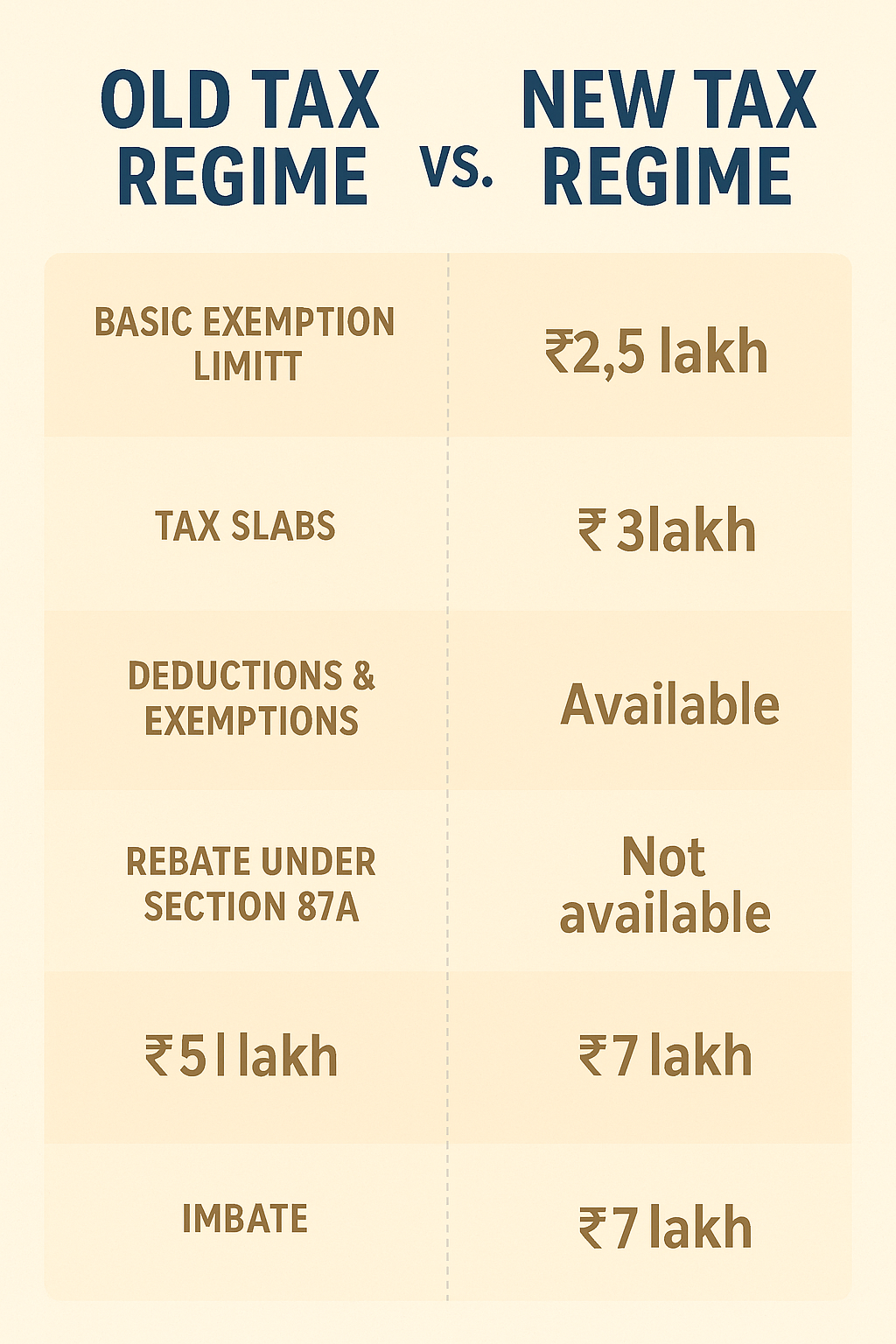📊 Old Tax Regime vs. New Tax Regime – Detailed Comparison


1. Introduction
Since FY 2020–21 (AY 2021–22), Indian taxpayers have been given the option to choose between:
- Old Tax Regime → Higher tax rates but with many exemptions and deductions.
- New Tax Regime → Lower tax rates but with minimal exemptions/deductions.
This flexibility means you must compare both systems each year to decide which one saves you more tax.
2. Tax Slab Rates
🟢 New Tax Regime (as per Budget 2023–24, effective AY 2024–25)
| Income Range (₹) | Tax Rate |
|---|---|
| 0 – 3,00,000 | Nil |
| 3,00,001 – 6,00,000 | 5% |
| 6,00,001 – 9,00,000 | 10% |
| 9,00,001 – 12,00,000 | 15% |
| 12,00,001 – 15,00,000 | 20% |
| Above 15,00,000 | 30% |
✅ Standard Deduction of ₹50,000 is now allowed in the new regime.
✅ Rebate under Section 87A → Income up to ₹7 lakh = Zero tax.
🔵 Old Tax Regime
| Income Range (₹) | Tax Rate |
|---|---|
| 0 – 2,50,000 | Nil |
| 2,50,001 – 5,00,000 | 5% |
| 5,00,001 – 10,00,000 | 20% |
| Above 10,00,000 | 30% |
✅ Rebate under Section 87A → Income up to ₹5 lakh = Zero tax.
✅ Multiple exemptions & deductions available.
3. Key Differences
| Feature / Aspect | Old Regime | New Regime |
|---|---|---|
| Tax Rates | Higher | Lower |
| Exemptions/Deductions | 70+ options (HRA, 80C, 80D, LTA, etc.) | Very limited (Std. Deduction, NPS 80CCD(2)) |
| Standard Deduction | ₹50,000 | ₹50,000 (since 2023) |
| Rebate Limit (87A) | Up to ₹5 lakh income = Nil tax | Up to ₹7 lakh income = Nil tax |
| Best For | Taxpayers with high investments & rent | Taxpayers with fewer investments/younger earners |
| Flexibility | Allows restructuring salary to save tax | Simpler, less paperwork |
| Complexity | High – must manage proofs & claims | Low – minimal documentation |
4. Who Should Choose Which?
- Old Regime is better for you if:
✅ You claim high deductions like:- 80C (PF, ELSS, LIC, PPF) → up to ₹1.5 lakh
- 80D (Health Insurance) → ₹25k–₹1 lakh
- HRA, LTA, Home Loan interest (Section 24b)
✅ You pay high rent and benefit from HRA.
✅ You actively invest in tax-saving instruments.
- New Regime is better for you if:
✅ You don’t invest much in tax-saving schemes.
✅ Your salary structure has fewer exemptions.
✅ You prefer simplicity without paperwork.
✅ Your annual income is up to ₹7 lakh (zero tax with rebate).
5. Case Study Comparison
Case 1 – Salaried Person with Investments
- Salary: ₹12 lakh
- Investments under 80C: ₹1.5 lakh
- 80D: ₹30k
- HRA: ₹1.2 lakh
👉 Old Regime Tax: ~₹1.12 lakh
👉 New Regime Tax: ~₹1.35 lakh
✅ Old Regime better
Case 2 – Salaried Person without Investments
- Salary: ₹9 lakh
- No deductions claimed
👉 Old Regime Tax: ~₹72,800
👉 New Regime Tax: ~₹46,800
✅ New Regime better
6. Conclusion
Both regimes have their pros and cons.
- If you’re disciplined in tax-saving investments, the Old Regime often works better.
- If you’re a young earner, non-investor, or want simplicity, the New Regime is usually better.
💡 Best practice → Use an Income Tax Calculator each year to compare both regimes before filing your ITR.
